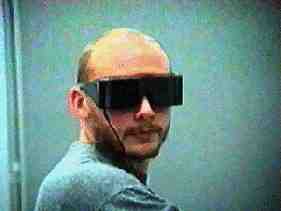
Group of lines? Six triangles? or a Cube?
Perception of Form and Space Using Stereoscopic Vision
| The human brain tends to understand the information it receives from the eyes in the easiest possible way. Most people would describe the group of lines to the left as "six triangles" because this description is short does not require perception of a 3D object. Most people would describe the group of lines to the right as a "cube" because a 2D perception would need a long description of the relations of the lines. Without stereoscopic vision it is impossible to be absolutely sure whether these lines represents a 3D cube, six 2D triangles or simply a group of linear elemnts. Stereoscopic vision enhances perception of architectural forms and spaces. The following pages show some experimental work of stereo rendering and stereo photography of architectural objects to be seen using shutter glasses and red-blue glasses. For your feedback please contact me a.okeil@uaeu.ac.ae | 
Group of lines? Six triangles? or a Cube? |
Techniques of Stereoscopic Vision
Stereoscopic vision is the result of having two eyes. Because our eyes are set slightly apart (typically 6.5 cm from pupil to pupil), each eye sees a slightly different image. The information from each eye is processed and combined in the brain to present a single image of depth. To reproduce this phenomenon artificially, one has simply to provide the necessary left- and right-eye images and a means for the viewer to process those images as usual. There are a few ways to accomplish this.
| Liquid Crystal Shutter Glasses Use alternate information for both eyes . You need shutter glasses linked to the computer that enable synchronically the proper side. Click here to go to the LCD page. |  |
| Red/Blue Glasses In this case, the information for both eyes are combined in one image that is separated again by the filtering action of red/blue colored glasses. Click here to go to the anaglyph page. |  |
| Polarized Glasses Here, both images with perpendicularly polarized lights are combined. Polarized glasses, may select the proper image to each eye. | |
| Crossing Eyes In this way, both images are shown one side to the other and you must cross your eyes in order to overlap the pictures. | |
| Parallel Viewing Here, both images are merged and you must relax the eyes muscles to see the 3D effect. |